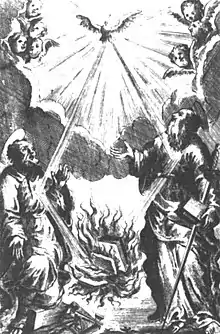Feeneyism is a Christian doctrine, associated with Leonard Feeney, which advocates an interpretation of the dogma extra Ecclesiam nulla salus ("outside the Church there is no salvation") which is that only Catholics can go to heaven and that only those baptised with water can go to heaven. Feeneyism opposes the doctrines of baptism of desire and baptism of blood as well as the view that non-Catholics can go to heaven.
Feeneyism is considered a heresy by the Catholic Church; some Catholics refer to Feeneyism as the Boston heresy.
Leonard Feeney
Feeney was a Roman Catholic priest and a member of the Jesuit order. The order dismissed Feeney in 1949 for disobedience; later, on 4 February 1953, the Holy Office declared him excommunicated "on account of grave disobedience to Church Authority, being unmoved by repeated warnings".[1][2]
Feeney co-founded the group known as the Slaves of the Immaculate Heart of Mary with Catherine Goddard Clarke.
Feeney reconciled with the Catholic Church in 1972 without any recantation from his part.[3][2]
Doctrine
The doctrine of Feeneyism is associated with the position of Leonard Feeney (1897–1978), a Jesuit priest of Boston, on the doctrine extra Ecclesiam nulla salus. Feeneyism's interpretation of the doctrine extra Ecclesiam nulla salus ("outside the Church there is no salvation") is that only Catholics can go to heaven and that only those baptised with water can go to heaven. Feeneyism opposes the doctrines of baptism of desire and baptism of blood as well as the view that non-Catholics can go to heaven.[4][5][6][7]
Feeneyism is considered a heresy by the Catholic Church; some Catholics refer to Feeneyism as the Boston heresy.[4][5][6]
Feeney rejected what was the definition of the Catholic Church of baptism of desire at the time, i.e. the idea that people who openly affiliated with the Catholic Church as well as those spiritually linked to the Catholic Church through an implicit desire could be saved.[5][6]
Condemnation of Feeneyism
In a 1949 letter to Cardinal Cushing, Archbishop of Boston, the Holy Office condemned Feeney's teaching that only those formally baptized in the Catholic Church can be saved. The Holy Office affirmed that those baptized by their desire can be saved. This letter was sent by Cardinal Francesco Marchetti Selvaggiani to Cardinal Cushing. This letter stated among other things:[8][9]
The same in its own degree must be asserted of the Church, in as far as She is the general help to salvation. Therefore, that one may obtain eternal salvation, it is not always required that he be incorporated into the Church actually as a member, but it is necessary that at least he be united to Her by desire and longing. However, this desire need not always be explicit, as it is in catechumens; but when a person is involved in invincible ignorance God accepts also an implicit desire, so called because it is included in that good disposition of soul whereby a person wishes his will to be conformed to the will of God. These things are clearly taught in that dogmatic letter which was issued by the Sovereign Pontiff, Pope Pius XII, on June 29, 1943, On the Mystical Body of Jesus Christ (AAS, Vol. 35, an. 1943, p. 193 ff.). For in this letter the Sovereign Pontiff clearly distinguishes between those who are actually incorporated into the Church as members, and those who are united to the Church only by desire.
— Letter of the Holy Office
This letter is referenced in a footnote of the Catechism of the Catholic Church, in its section "Outside the Church there is no salvation", paragraph 847,[10] as well as in a footnote in Lumen gentium.[11]
Feeneyite groups
See also
References
- ↑ The Holy See. "ACTA APOSTOLICAE SEDIS COMMENTARIUM OFFICIALE ANNUS XXXX V - SERIES II - VOL. XX" (PDF). vatican.va.
- 1 2 "Leonard Feeney, Jesuit Priest, 80; Ousted in Dispute Over Salvation". The New York Times. 1978-02-01. ISSN 0362-4331. Retrieved 2021-12-26.
- ↑ Madrid, Patrick; Vere, Pete (2004). More Catholic Than The Pope: An Inside Look At Extreme Traditionalism. Our Sunday Visitor. p. 72. ISBN 9781931709262.
- 1 2 Mick, Lawrence E. (2007). "Baptism – Call to Carry On the Mission". Baptism. Liturgical Press. p. 7. ISBN 978-0-8146-3188-1.
- 1 2 3 Feldberg, Michael (2012). "American Heretic: The Rise and Fall of Father Leonard Feeney, S.J." American Catholic Studies. 123 (2): 109–115. ISSN 2161-8542. JSTOR 44195416.
- 1 2 3 Carey, Patrick (2007). "Avery Dulles, St. Benedict's Center, and No Salvation outside the Church, 1940-1953". The Catholic Historical Review. 93 (3): 553–575. ISSN 0008-8080. JSTOR 25164314.
- ↑ "Why is the Vatican taking action against the Slaves of the Immaculate Heart of Mary?". Catholic Herald. 2019-01-17. Retrieved 2021-12-28.
- ↑ "Letter of the Sacred Congregation of the Holy Office". August 8, 1949. Archived from the original on March 11, 2000.
- ↑ "Archbishop Richard J. Cushing". 2019-04-03. Archived from the original on 2019-04-03. Retrieved 2019-10-11.
- ↑ St Ignatius (December 1993). The Companion to The Catechism of the Catholic Church: A Compendium of Texts Referred to in The Catechism of the Catholic Church. Ignatius Press. pp. 361–. ISBN 978-0-89870-451-8.
- ↑ "Library : Extra Ecclesiam Nulla Salus: Father Feeney Makes a Comeback". www.catholicculture.org. Retrieved 2021-12-27.
Further reading
- Pepper, George B. (1988). The Boston Heresy Case in View of the Secularization of Religion: A Case Study in the Sociology of Religion. Lewiston, New York: Edwin Mellen Press. ISBN 978-0-88946-856-6.
